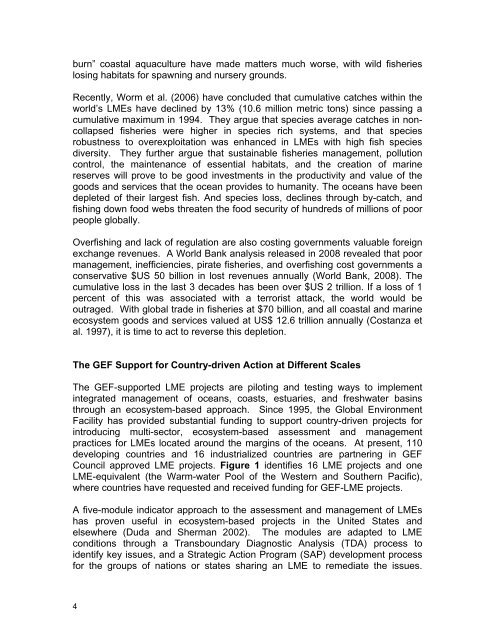Sustaining the World's Large Marine Ecosystems
Sustaining the World's Large Marine Ecosystems
Sustaining the World's Large Marine Ecosystems
You also want an ePaper? Increase the reach of your titles
YUMPU automatically turns print PDFs into web optimized ePapers that Google loves.
urn” coastal aquaculture have made matters much worse, with wild fisheries<br />
losing habitats for spawning and nursery grounds.<br />
Recently, Worm et al. (2006) have concluded that cumulative catches within <strong>the</strong><br />
world’s LMEs have declined by 13% (10.6 million metric tons) since passing a<br />
cumulative maximum in 1994. They argue that species average catches in noncollapsed<br />
fisheries were higher in species rich systems, and that species<br />
robustness to overexploitation was enhanced in LMEs with high fish species<br />
diversity. They fur<strong>the</strong>r argue that sustainable fisheries management, pollution<br />
control, <strong>the</strong> maintenance of essential habitats, and <strong>the</strong> creation of marine<br />
reserves will prove to be good investments in <strong>the</strong> productivity and value of <strong>the</strong><br />
goods and services that <strong>the</strong> ocean provides to humanity. The oceans have been<br />
depleted of <strong>the</strong>ir largest fish. And species loss, declines through by-catch, and<br />
fishing down food webs threaten <strong>the</strong> food security of hundreds of millions of poor<br />
people globally.<br />
Overfishing and lack of regulation are also costing governments valuable foreign<br />
exchange revenues. A World Bank analysis released in 2008 revealed that poor<br />
management, inefficiencies, pirate fisheries, and overfishing cost governments a<br />
conservative $US 50 billion in lost revenues annually (World Bank, 2008). The<br />
cumulative loss in <strong>the</strong> last 3 decades has been over $US 2 trillion. If a loss of 1<br />
percent of this was associated with a terrorist attack, <strong>the</strong> world would be<br />
outraged. With global trade in fisheries at $70 billion, and all coastal and marine<br />
ecosystem goods and services valued at US$ 12.6 trillion annually (Costanza et<br />
al. 1997), it is time to act to reverse this depletion.<br />
The GEF Support for Country-driven Action at Different Scales<br />
The GEF-supported LME projects are piloting and testing ways to implement<br />
integrated management of oceans, coasts, estuaries, and freshwater basins<br />
through an ecosystem-based approach. Since 1995, <strong>the</strong> Global Environment<br />
Facility has provided substantial funding to support country-driven projects for<br />
introducing multi-sector, ecosystem-based assessment and management<br />
practices for LMEs located around <strong>the</strong> margins of <strong>the</strong> oceans. At present, 110<br />
developing countries and 16 industrialized countries are partnering in GEF<br />
Council approved LME projects. Figure 1 identifies 16 LME projects and one<br />
LME-equivalent (<strong>the</strong> Warm-water Pool of <strong>the</strong> Western and Sou<strong>the</strong>rn Pacific),<br />
where countries have requested and received funding for GEF-LME projects.<br />
A five-module indicator approach to <strong>the</strong> assessment and management of LMEs<br />
has proven useful in ecosystem-based projects in <strong>the</strong> United States and<br />
elsewhere (Duda and Sherman 2002). The modules are adapted to LME<br />
conditions through a Transboundary Diagnostic Analysis (TDA) process to<br />
identify key issues, and a Strategic Action Program (SAP) development process<br />
for <strong>the</strong> groups of nations or states sharing an LME to remediate <strong>the</strong> issues.<br />
4









